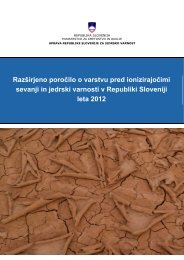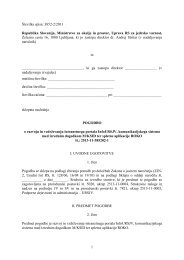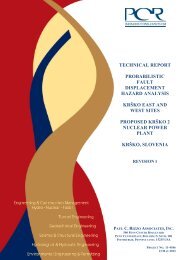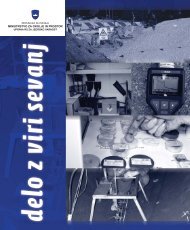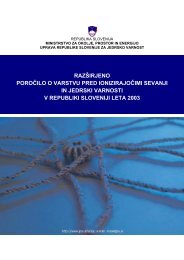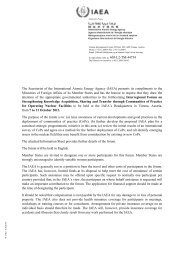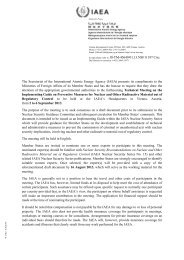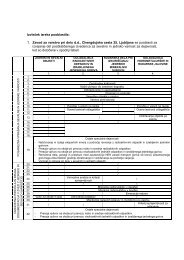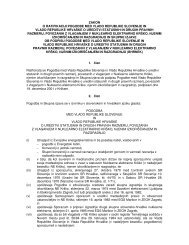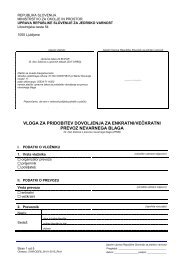L \J'J - Uprava Republike Slovenije za jedrsko varnost
L \J'J - Uprava Republike Slovenije za jedrsko varnost
L \J'J - Uprava Republike Slovenije za jedrsko varnost
You also want an ePaper? Increase the reach of your titles
YUMPU automatically turns print PDFs into web optimized ePapers that Google loves.
msrs<br />
INSTITUT<br />
DE RADIOPROTECTION<br />
ET DE SORETE NUClEAIRE Fontenay aux roses, {~ ur'r .9~ 1-0 13<br />
Le Direct eur general<br />
IRSN /DIRI2013-005 2 s<br />
R :='PUBL I K A S L ') VE N IJh<br />
MIN ISTRSTVO ZA OK O c... JC IN PR OS TOR<br />
UP R AV A R EPUB LI KE SL OV EN IJ E<br />
Z A JEO R SK O VA RN O S T<br />
Zele zr c ces'c . '5 ~ ,,575~ ' 0: ' '-JU ~U A r-, J'.<br />
O A -I U ' 111, > Iv" c>'", 'I<br />
1\ 2 ,~ 08. iT'!',<br />
~-<br />
S t e \' , K a ' I I<br />
3511- b/:JD ~ 3/11 i pr,/,<br />
09 ,en. \ L \ J'J<br />
I<br />
l-IYf<br />
Mr. And rej STRITAR<br />
Director<br />
Ministry of agriculture and the environment<br />
Slovenian Nuclear Safety Administration<br />
Litostrojska cesta 54<br />
1000 Ljubljana<br />
Slovenia<br />
Objet :<br />
Clarifications concerning information published on the SNSA website and the May<br />
2013 issue of Slovenian Nuclear News<br />
Dear Mr. Stritar,<br />
IRSN participated last April to the meeting organized at your request in Ljubljana in orde r to clarify<br />
geological issues at the Krsko site. Following this meeting, comments and conclusions were published<br />
Adresse Courrier<br />
BP 17<br />
92262 Font enay-aux-Roses<br />
Cedex France<br />
on the SNSA website as well as in the May 2013 issue of Slovenian Nuclear News (see Appendix). After<br />
careful reading of these texts, I would like to draw your attention to some elements that I think would<br />
deserve some modification or additional clarification.<br />
Tel. : +33 (0)1 58 3584 89<br />
Fax : +33 (0 )1 583571 52<br />
jacques.repussard@irsn.fr<br />
Siege social<br />
31, avode la Division Leclerc<br />
92260 Font enay-aux-Roses<br />
Standard +33 (0 )1 58358888<br />
RCS Nanterre B 440 546 01B<br />
Concerning the published conclusions on the capability of the fault and its potential impact on th e<br />
Krsko 1 Nuclear power plant, IRSN does agree that PFDHA method is acceptable for assessing the risk<br />
of displacement at the location of the plant if it is supported by sufficient data , especially issued from<br />
local investigations. As stated in the April meeting, IRSN recognizes that the results obtained by P.<br />
Rizzo are reassuring with regard to the safety of the plant; IRSN is however not in a position to<br />
validate or invalidate these results since its experts have not been involved in the PFDHA study nor<br />
had the mandat e or opportunity of reviewing it. I according ly consider that the corresponding<br />
statement published in Slovenian Nuclear News does not corres pond to the position expressed by IRSN<br />
during the meet ing [see: "the Consortium agreed that even if we assume the capability of Libna<br />
Systeme de management<br />
de la qoante IRSN cert i fi e
I RS ~']<br />
INSl ITUl<br />
Of RADI O PROTECTI O N<br />
ETDE SUIlElt N UClEAIRE<br />
fault , its impact is small and the input data for seismic design of the existing NPP Krsko need not be<br />
changed"].<br />
Concerning the possible need to revise the input data for the seismic design of Krsko 1 plant, IRSN<br />
acknowledges that contrarily to the article in the Slovenian Nuclear News, SNSA communication on<br />
the website adequately reports IRSN's expert position , expressed during the April meeting , that there<br />
are grounds to update the 2004 PSHA study that form the basis for establishing the level of seismic<br />
ha<strong>za</strong>rd to be considered . IRSN confirms that, according to the preliminary studies carried out within<br />
the framework of the Krsko 2 project, the question of updating the 2004 model is raised and should be<br />
invest igated further. This issue has been recently discussed with GEN as exposed further below.<br />
Finally , SNSA website mentions that no clear indication was given by IRSN experts during the April<br />
meeting on the ways to tackle the issues raised by the results of the geological investigations. In order<br />
to further clarify these issues, a meeting was held in Vienna on July 3'd, 2013 between M. Martin<br />
Novsak, Director of GEN, and M. Francois Besnus, Director of Waste and geosphere at IRSN . Concerning<br />
the PFDHA studies, IRSN has suggested that, in order to consolidate P. Rizzo's conclusions, GEN makes<br />
sure that the PFDHA results obtained is supported by sufficient data , especially the local data<br />
presented in the Libna report and its appendices, so that the uncertainties related to the method are<br />
reasonably constrained. A new peer review could be appointed so as to include the results of the<br />
investigations still ongoing. Concerning the updating of the 2004 PSHA studies, IRSN has recommended<br />
that a cautious approach be implemented, based on data acquired and preliminary PSHA studies<br />
realized during the Krsko 2 project but refined and possibly complemented by other methods<br />
(comparison of dete rministic and probabilistic methodologies, refinement of the earthquake<br />
catalogue ...) as was initially envisaged for the second phase of the project (see minutes appendix).<br />
Another approach would be to initiate a "SSHAC level 3" process that has proved useful for<br />
conciliating the various expert opinions on seismic ha<strong>za</strong>rd assessment.<br />
I wish to inform you that IRSN has no intention to participate to the tasks that the above suggestions<br />
may entail, if it was decided to implement them. I also want to inform you that, in order to facilitate<br />
the possible follow-up of the assessment of the seismic risk at Krsko site, all the relevant data , results<br />
and studies that IRSN has acquired or carried out during the Krsko 2 project have been forwarded to<br />
GEN Energija.<br />
I sincerely hope these clarifications will lead to constructive approaches for solving the questions that<br />
may still arise concerning the assessment of the seismic ha<strong>za</strong>rd at Krsko site,<br />
- 2 -
asra<br />
INSTITu r<br />
Of RADIO PROTE CTION<br />
ETDE SURETt N UCl tA IR(<br />
Appendix<br />
Translation of SNSA web site: Downloaded on the July 18 th ,<br />
2013 from<br />
http: //www.ursjv.gov.si/si/info/posamezne <strong>za</strong>deve/o potresn i <strong>varnost</strong>i nek/<br />
THE SEISMIC SAFETY OF THE KRSKO NPP<br />
15 MARCH 2013<br />
The Director of GEN Energija , Mr Martin Novsak, verbally informed the Slovenian Nuclear Safety<br />
Administration (SNSA) on 25 January 2013 about a letter from the French IRSN Institute on the seismic<br />
safet y of the Krsko site . In the interest of the public, on thi s web site we publish all the documents<br />
received or sent by the SNSA in connection with this issue in chronological orde r. We published a<br />
summary of the genesis of this issue as a news story on 15 March 2013.<br />
DATE OF RECEIPT OF THE DOCUMENT (wi t h the date of creation ):<br />
11 March 2013, Dopis GEN Energije d.o.o. (27 February 2013)<br />
11 March 2013, Pismo instit ut a IRSN podjetju GEN Energije d.o.o. (9 January 2013)<br />
11 March 2013, Odgovor GEN Energije d.o.o. (26 February 2013)<br />
11 March 2013, Studija Geoloskega <strong>za</strong>voda <strong>Slovenije</strong> 0 raziskavah na Libni (April 2011 )<br />
11 March 2013, Mnenje podjetja Paul C. Rizzo Associates (25 June 2012)<br />
11 March 2013, Tehnicno porocilo GEN Energije d.o.o. 0 pismu IRSN (19 December 2011 )<br />
11 March 2013, Mnenje recenzentov 0 PFDHA (20 January 2013)<br />
11 March 2013, Porocilo podjetja Paul C. Rizzo Associates (15 February 2013)<br />
11 March 2013, Pismo Geoloskega <strong>za</strong>voda <strong>Slovenije</strong> (13 February 2013)<br />
11 March 2013, Pismo instituta BRGM (19 February 2013)<br />
15 March 2013, Obvestilo <strong>za</strong> javnost URSJV<br />
18 March 2013, Dopis URSJV GEN-u (18 March 2013)<br />
20 March 2013, Dopis URSJV ARAO (20 March 2013)<br />
21 March 2013, Dopis URSJV NEK-u (21 March 2013)<br />
28 March 2013, Dopis lEG - Obvestilo <strong>za</strong> javnost (26 March 2013)<br />
29 March 2013, Dopis URSJV IRSN-ju (29 March 2013)<br />
29 March 2013, Seznanitev z IRSN pismom in odgovorom - dopis GEN -a URSJV (27 March 2013)<br />
29 March 2013, Porocilo Paleoseismological investigations of the Libna fault. Trench in Stari Grad (27<br />
November 2008)<br />
29 March 2013, Geotechnical, Geological , and Seismological (GG&S) Evaluations - NEK<br />
29 March 2013, Ctanek revije Earth Science Reviews (<strong>za</strong>loznik Elsevier) : The relationship between<br />
displacement and lenght of faults: a review (2005)<br />
2 April 2013, Pismo Martina Bratani ca URSJV (2 April 2013)<br />
8 April 2013, Pismo URSJV Gen-u (8 April 2013)<br />
9 April 2013, Vabilo na sestanek s CIani konzorcija (8 April 2013)<br />
26 APRIL 2013 - Working meeting with representatives of the Consortium in Ljubljana<br />
Agenda<br />
Note of the meeting (GEN)<br />
Presentation slides<br />
Uvodna predstavitev dr . Andreja Stritarja<br />
Namen in obseg narocenih studij - J. Spiler , GEN<br />
Raziskave v sklopu konzorcija - Ba<strong>za</strong>rgan-Sabet Behrooz, BRGM<br />
Prelom Libna - M. Bavec, GeolS<br />
Predstavitev IRSN<br />
Geologija , tektonika in seizmotektonika Krskega polja - M. Bavec, GeolS<br />
Karakteri<strong>za</strong>cija preloma Libna - M. Cline , Rizzo<br />
PFDHA anali<strong>za</strong> - R. Quittmeyer, Rizzo<br />
Position of the SNSA after the working meeting<br />
On Friday, 26 April, GEN energij a, on the initiative of the SNSA organised a wor king meeti ng in<br />
Ljubljana of the members of a Consortium th at has over the years studied the suitability of the site in<br />
the Krsko area for a possib le second nuclear power plant. The meeting was attended by<br />
repr esentatives of all members of the Consortium , namely France's BRGM and IRSN insti t uti ons, the<br />
Geological Survey of Slovenia (Geol S) and the Slovenian National Building and Civil Engineering<br />
- 3 -
asra<br />
INSTlTU T<br />
DE RADI OPROH CTION<br />
[T DE SUHTt N UCtt .&lR[<br />
Institute (ZAG). Other participants included representatives of the U.S. company P. Rizzo, the Krsko<br />
Nuclear Power Plant , GEN energija, the Faculty of Civil Engineering (FGG) , the Agency for Radioactive<br />
Waste Management (ARAO) and the Slovenian Nuclear Safety Administration (SNSA). The meeting was<br />
expected to provide information on the work of the Consortium and try to clarify differences in the<br />
technical interpretations of the findings of the research. An important reason for the meeting were<br />
the questions raised by a letter from the IRSN Institute to the company GEN energija in January this<br />
year. We were informed that in the meantime the IRSN had withdrawn from the Consortium.<br />
At the beginning of the meeting the director of the SNSA, Dr Andrej Stritar, presented three key issues<br />
that have crystallized within the SNSA in recent months in the wake of the review and analysis of the<br />
documents received and to which he expected to get answers. These issues were as follows:<br />
1. How was quality assurance ensured during the work of the Consortium as it is not clear from<br />
the documents received that all the members of the Consortium approve of them or that the<br />
documents have been properly revised or reviewed? The SNSA has not received any joint<br />
reports from the members of the Consortium.<br />
2. What do the results of their research mean with regard to input data for the antiseismic<br />
design of the Krsko Nuclear Power Plant? Will the design accelerations and design spectra, as<br />
the basis for the design of the buildings and technological systems, change? Does the<br />
possibility of a Libna Hill fault pose an imminent threat to the movement of objects on the<br />
site?<br />
3. If the input data from the previous question do actually change, what will it mean for the<br />
antiseismic safety of the Krsko NPP? This question is not really intended for the Consortium,<br />
but for the Krsko NPP.<br />
After the meeting, the SNSA understood the current situation as follows:<br />
1. The participants agreed that there were indications that a Libna Hill fault was possible, but<br />
they did not agree on the extent to which this was certain mainly due to data on the dating<br />
(age determination) of the Plio-Quaternary deposit , which is unreliable and significantly<br />
changes the current knowledge of the age of this sediment in the Krsko basin. An important<br />
point was also that participants agreed that even if the possibility of a Libna Hill fault<br />
rupture was assumed, its impact would be so small that it would not change the seismic<br />
source considered in evaluating the seismic safety of the Krsko Nuclear Power Plant<br />
2. The IRSN did not explain in detail why they felt the need to emphasise their understanding of<br />
the issue of the Libna Hill fault in a separate letter. When asked directly what should be done<br />
regarding their warning concerning the Libna Hill fault, the IRSN provided no clear answer.<br />
They believe, however , that it is necessary to review the methodology for calculating the<br />
total seismic load irrespective of the possibility of a Libna Hill fault.<br />
3. The participants agreed that the new findings did not suggest a major immediate danger due<br />
to the potential formation of cracks on the surface. They agree that a PFDHA (Probabilistic<br />
Fault Displacement Ha<strong>za</strong>rd Analysis) is a suitable tool for assessing potential ground<br />
movements on the site of the facility.<br />
4. The representatives of the P. Rizzo company presented the preliminary results of a PFDHA<br />
study they are conducting for GEN energija. The calculation methodology takes into account<br />
the effects of all the faults in the wider area around the site, including the Libna Hill fault.<br />
The findings that the probability of movements of terrain that can affect the structure and<br />
thus the safety of the power plant is well below the level of existing risk due to power plant<br />
operation are reassuring.<br />
The SNSA will closely follow the continuing research and clarifications of ambiguities, which have<br />
been anticipated by both GEN energija and the Krsko NPP. In the next few months they will try to<br />
obtain harmonised positions from the members of the Consortium .<br />
The SNSA is of the opinion that on the basis of current knowledge there is no reason to take any<br />
immediate action in relation to the antiseismic safety of the Krsko NPP. In the long term, the SNSA<br />
particularly insists on the Krsko NPP constantly improving its capacity to cool the reactor core in any<br />
situation and making arrangements for the delivery of the necessary electricity and water to support<br />
the cooling systems in such situations. This is the focus of the Safety Upgrade Programme, which we<br />
requested in 2011 and according to which by 2016 the Krsko NPP should have incorporated almost<br />
everything that is known today about ensuring the preparedness of nuclear power plants to withstand<br />
severe external events, including the worst earthquakes.<br />
The SNSA' s follow-up act ivities<br />
26 April 2013, Dopis Direktorata <strong>za</strong> energijo<br />
13 May 2013, Odgovor URSJV Direktoratu <strong>za</strong> energijo<br />
17 May 2013, Vabilo na sestanek z GEN, NEK in ARAO<br />
24 May 2013, PFDHA studija<br />
- 4-
IRS~~<br />
IN S'IT U J<br />
DE RAD I O PROTE C TI O N<br />
[ T DE SUH rE N UCl[ ,AI!H<br />
Note of the SNSA meeting on 17 May 1013<br />
The purpose of the meeting was to inform the SNSA of the planned follow-up activities and to provide<br />
measures based on the results of the meeting of 26 April 2013 with the members of the Consort ium ,<br />
BRGM, IRSN , GeoZS and ZAG with regard to the issue of the Libna Hill fault.<br />
Participants : Representatives of the Slovenian Nuclear Safety Administration (SNSA), GEN energija,<br />
the Krsko NPP and the Agency for Radioactive Waste Management (ARAO)<br />
At the beginning of the meeting GEN energija introduced a project for geological , geotechnical and<br />
seismic surveys carried out since 2007 by a Consortium led by the BRGM. GEN is now debat ing<br />
terminating the contract with the Consortium because the IRSN has already withdrawn from the<br />
Consortium in January 1013 on its own initiat ive.<br />
During the implementation of the contract, two annexes were added to it for the implementation of<br />
additional seismic profiles, additional wells , geophysical surveys and an additional laboratory analysis.<br />
During the implementation of the contract with the Consortium , GEN also entered into a contract with<br />
the company Rizzo for the review of the Consortium 's reports. Subsequently, it also made<br />
arrangements with Rizzo for conducting geomorphological surveys by using L1DAR DMV, the<br />
determination of high resolution seismic profiles and the determining of the age of the Plio<br />
Quaternary sediment. The age of the sediment will be determined by using optically stimulated<br />
luminescence (OSL) and "Cosmogenic Radionuclide" dating (CRN) . Measurements and opinions on<br />
measurements will be obtained from accredited laboratories (Bern, Purdue University Prime<br />
Laboratory and Utah State University). The estimated time of the completion of the additional surveys<br />
is the end of 2013. GEN has also ordered a PFDHA analysis from Rizzo, as well as a sensitivity analysis<br />
with conservative assumptions, the preliminary results of which were presented at the meeting held<br />
on 26 April 2013.<br />
The results of the surveys to date do not necessitate immediate action as the seismic safety of the<br />
Krsko NPP is not compromised. Nevertheless, the planned surveys should be completed.<br />
The SNSA pointed out that before the end of the contract with the Consortium it would be useful to<br />
obtain adequately harmonised and signed reports on the work performed from its members.<br />
Preferably, the reports should specify what they agree on, as well as what they do not agree on. The<br />
SNSA recommends that the members of the Consortium confirm in writing the view expressed at the<br />
meeting on 26 April 2013 that the impact of the Libna Hill fault, if it is capable , is so small that it<br />
would not change the seismic source taken into account in assessing the seismic safety of the Krsko<br />
NPP.<br />
A proposal by a representative of the IRSN from the meeting of 26 April 2013 that the Probabilistic<br />
Safety Ha<strong>za</strong>rd Analysis (PSHA) completed for the Krsko NPP in 2004 should be repeated was also<br />
addressed. The participants agreed (the same conclusion also follows from presentations by the other<br />
members of the Consortium at the meeting of 26 April 2013) that there was no new confirmed<br />
geological information that would significantly change the geotectonic profile of the Krsko basin that<br />
was used as input information for the 2004 PSHA. In addition, it would be better to wait with<br />
repeating the PSHA because international debates on corrections to the applied mathematical models<br />
and assumptions are still in progress. It would make sense to repeat the PSHA in a few years when<br />
changes to the models are agreed upon and become standard practice and when there is new seismic<br />
data available on the Krsko basin. During the review of the PSHA the Krsko NPP should also reasonably<br />
take account of the recommendations made by the IRSN in 2004.<br />
The Krsko NPP informed the participants that by the end of June 2013 it would prepare an analysis of<br />
the response of the Krsko NPP to the PFDHA and would send it to the SNSA along with an independent<br />
expert opinion to be prepared by the FGG from Ljubljana (Prof. Fajfar).<br />
The ARAO stressed that the safety analyses for the future disposal site for low and intermediate level<br />
waste (L1LW) have already incorporated a scenario in which shortly after the closure of the disposal<br />
site the technical barriers are torn down and damaged, which also includes an earthquake event. This<br />
means that the technical barriers will lose their property of physically retaining radionuclides , while<br />
maintaining the chemical retention (sorbtion) property. Even in this case analyses and evaluations do<br />
not indicate a radiological impact of the disposal site that would be above the permissible limit.<br />
Conclusions:<br />
The SNSA expects GEN to obtain signed final reports from the Consortium and to try to obtain<br />
a written statement from the members of the Consortium as to the impact of the Libna Hill<br />
fault, even if it is capable , on the input data used in the PSHA.<br />
- 5 -
asra<br />
INS TITU T<br />
DE RA DI OPR O TECTION<br />
fT DESUH H NU(ltAI RE<br />
GEN will complete the characterisation of the Libna Hill fault with its contractual partner by<br />
the end of 2013. The age of the Plio-Quaternary deposit will have also been determined by<br />
then.<br />
If a need arises, the Krsko NPP will carry out PSHAs in a few years, once the geological<br />
surveys have been completed and, if necessary, once the seismotectonic model of the Krsko<br />
basin and surrounding area has been revised and the revised methodology for such analyses<br />
has been reviewed and made available.<br />
In its safety analyses for the disposal site for radioactive waste the ARAO must also take into<br />
account any new facts regarding likely seismic events that have and will be obtained through<br />
surveys conducted by GEN energija.<br />
New reports<br />
July 2013, Final Technical Report - Sensitivity Analysis PFDHA (28 June 2013)<br />
- 6 -



